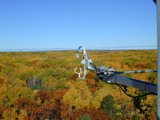
Some Trees Use Less Water Amid Rising Carbon Dioxide, Paper Says, July,
A view seen through a fisheye lens of the forest canopy from the University of Michigan Biological Station. New research suggests that trees in some parts of the world are having to pull less water out of the ground to achieve growth. A paper published Wednesday suggests that trees in at least some parts of the world are having to pull less water out of the ground to achieve a given amount of growth. Some scientists say they believe that this may be a direct response to the rising level of carbon dioxide in the air from human emissions, though that has not yet been proved. If the research holds up, it suggests some potential benefits for forests. They might be able to make do with less water, for instance, becoming more resilient in the face of drought and higher temperatures as climate change proceeds. But the new finding also has potential downsides, scientists said. The immense volume of water that trees pull out of the ground winds up in the atmosphere, helping supply moisture to farming areas downwind of forests. So if trees use less water that could ultimately mean less rain for thirsty crops in at least some regions of the world.
Several scientists predicted that the new research would set off a flurry of efforts to clarify whether trees are really using less, and what the implications might be, not only for forests but for the human and ecological systems that depend on existing patterns of moisture flow. The work was led by Trevor F. Keenan of Macquarie University in Sydney, Australia, and published online Wednesday by the journal Nature.
The study is based on technology that, for about two decades, has allowed scientists to make careful measurements of the water vapor and other gases flowing in and out of forests. Large-scale patterns are starting to emerge. Examining 21 of these records for forests scattered across northern latitudes, Dr. Keenan’s group found that broad-leaved trees, in particular, are becoming more efficient in their water use. For a given amount, they are essentially able to take more carbon dioxide out of the atmosphere than they could only a decade ago.
In some places, particularly those where trees were already living at the limits of their natural range, large diebacks are under way. Millions of acres of forest have been lost in the American West, for example, because earlier snowmelt is reducing water supplies, and because winter temperatures are no longer cold enough to control beetle outbreaks. Fires seem to be worsening, too. At the same time, in some areas where forests are still comfortably within their preferred climatic range, they are doing better than in the past, possibly because the rising carbon dioxide level is essentially acting as a kind of plant fertilizer.
Source: http://www.nytimes.com